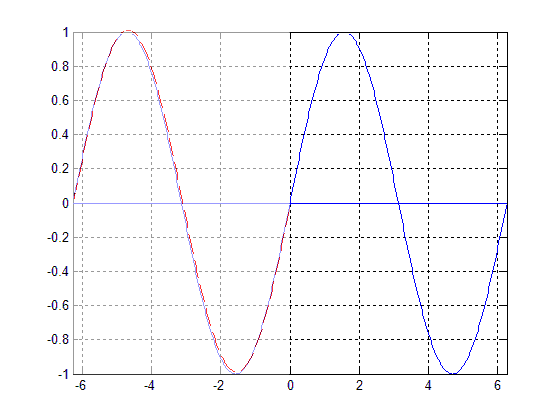| Line 3: | Line 3: | ||
[[Image:Periodic_blaskows_ECE301Fall2008mboutin.gif|frame|center|An example of a periodic function f(t)=sin(t+T). The dashed red line represents adding various values of T from T=0 to T=2pi. One can see that when T=2pi, the function is unchanged.]] | [[Image:Periodic_blaskows_ECE301Fall2008mboutin.gif|frame|center|An example of a periodic function f(t)=sin(t+T). The dashed red line represents adding various values of T from T=0 to T=2pi. One can see that when T=2pi, the function is unchanged.]] | ||
| + | |||
| + | ==Non-periodic Functions== | ||
| + | A non-periodic function does not remain self-similar for all integer multiples of its period. A decaying exponential is an example of a non-periodic function. The distance between consecutive peaks does not remain constant for all values of <math>x</math. Presented here is the function <math>f(t)=e^{0.2t}*sin(10t)</math>. | ||
| + | |||
| + | [[Image:Nonperiodic_blaskows_ECE301Fall2008mboutin.gif|frame|center|An example of a non-periodic function <math>f(t)=e^{0.2t}*sin(10t)</math>.]] | ||
Revision as of 12:26, 1 September 2008
Periodic Functions
The function $ f(t)=sin(t+T) $ is periodic, with a period of $ T=2\pi $. This means that for $ T=2n\pi $, n an integer, the function will be unchanged from when $ T=0 $.
Non-periodic Functions
A non-periodic function does not remain self-similar for all integer multiples of its period. A decaying exponential is an example of a non-periodic function. The distance between consecutive peaks does not remain constant for all values of $ x</math. Presented here is the function <math>f(t)=e^{0.2t}*sin(10t) $.
File:Nonperiodic blaskows ECE301Fall2008mboutin.gif
An example of a non-periodic function $ f(t)=e^{0.2t}*sin(10t) $.


